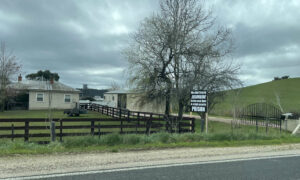Hobart in January. The city, which is never frenetic, slows to an indulgent meander for the warmest month of a fleeting summer.
Constitution Dock is crammed with yachts, the Taste Festival overflows with tourists and locals seize on the short window of warmth to escape to seaside shacks or potter in verdant gardens. As Premier, Paul Lennon would insist on joining the collective downing of tools. A leader of a small and largely uninspiring parliamentary team, the smart, hard-working former unionist did most of the heavy lifting in government and January was his time to recover; to retreat to the gothic Georgian sandstone pile he was slowly restoring in the tiny hamlet of Broadmarsh, northwest of Hobart. Out of mobile phone range, colleagues and journalists knew better than to bother Old Bluey, as he was known, during his sacred break.
On January 10, 2007, however, Lennon’s annual idyll was shattered by the front page of the local newspaper, The Mercury. It carried a report of a dummy-spit by a man he knew well, Gunns Ltd chairman John Gay. The timber baron was at the time seeking planning approval for the biggest project proposed for Tasmania since the great hydro dam-building days: a $2.4 billion pulp mill to be built near Bell Bay, in the Tamar Valley.
Gunns was having increasing difficulty meeting the exhaustive requirements of the pulp mill guidelines and Gay decided it was time to get things moving, January holidays or not. He told The Mercury that if the project could not be approved within six months, his company would forget the whole thing; ending hopes of 1600 construction jobs and a guaranteed future for the forestry industry.
Lennon immediately broke his precious January leave and made a 200km dash up the Midland Highway to Launceston. Here he soothed Gay, promising that the mill assessment would be concluded “as quickly as possible” and that his government would do all it could to make the process work for Gay.
And so he did.
…
Those who had helped build Gunns’ empire watched on with horror. “The native forest sawmilling business was the biggest in Australia and he just threw it away,” says one former senior Gunns figure. “It was slash and burn.” Even so, on February 7 last year it appeared L’Estrange’s “Bell Bay or bust” strategy had worked. Gunns announced it had found a white knight investor to fix its debt problems and resurrect the pulp mill. The Singapore-based Richard Chandler Corporation had agreed to pay $150m for a 39 per cent stake in Gunns as part of a larger $280m equity-raising package. Gunns and the mill were back from the brink. L’Estrange appeared redeemed.
However, Gunns’ foes of old had not yet buried the hatchet. The forest peace talks L’Estrange had facilitated were dragging on and while green groups praised the changes at Gunns they stopped well short of endorsing the pulp mill. Politically, the Greens Party – now in ruling alliances with Labor federally and in Tasmania – remained implacably opposed. The then federal Greens leader Bob Brown made contact with Chandler, informing him of the sordid history of the project and the ongoing opprobrium.
Brown and Tasmanian Greens leader Nick McKim met a due diligence team sent by Chandler to investigate. They warned the Singapore outfit it was buying into a world of trouble if it persisted in backing the mill. L’Estrange reached out to the people who had helped him stare down the old guard at Gunns, desperate for someone to say a good word about the reformed timber company to Chandler’s team. “L’Estrange rang me and asked, would I be prepared to meet with someone who was a possible [pulp mill] partner, and I said of course,” recalls Geoffrey Cousins. “I met with three or four of them in Sydney and told them that unless they were prepared to put themselves through some sort of public hearing process [to examine the gaps in the mill fast-track approval process] then they had no chance of ever getting their social licence. [I said] if you’re not prepared to do that, then go and look at old film clips of the Franklin Dam protests – because that’s what you’ll get.”
Chandler suddenly withdrew the offer on March 9 last year, only a month after it was made, explaining the equity deal did not meet its social criteria for investment. Chandler’s decision sent Gunns into a trading freeze from which it never emerged. When L’Estrange was unable to work up an alternative equity deal by August last year, the board was forced to concede the pulp mill was now no longer likely to proceed. This meant it had to write off the $217m spent on the project. Worse, it had to revise downward the value of assets linked to the project, notably its vast plantations, contributing to a $904m loss. By the end of September last year, it was in the hands of receivers. It was bust, not Bell Bay, after all.
Worse was to come for John Gay, too. Eighteen months after the coup that ended his career, he was charged with two counts of insider trading.
…
For his part, L’Estrange argues that despite his best efforts, the community and would-be investors never forgot or forgave the company for the Gunns 20 lawsuit or the pulp mill fast-track. “People never got over that. That history was always a burden in the process; it was always raised,” L’Estrange says. Still a believer in the mill’s business case, he predicts investors will purchase the project, its permits, land and plantation feedstock, as Gunns’ receivers and liquidators seek to recoup the banks’ investment.
Industry analysts believe L’Estrange was a man out of time. While he joined Gunns as timber division chief in 2008, he did not become CEO until July 2009 and was not fully in control until the departure of Gay and Gray in May 2010. “Greg L’Estrange made every effort he could to turn the tide but it was simply too late,” says pulp and paper analyst Robert Eastment. Unlike L’Estrange, Eastment is doubtful an investor will pick up the pulp mill project. “The very conditions that precluded a sale have not changed,” Eastment argues.
Whatever becomes of the pulp mill, Paul Oosting believes the demise of Gunns holds lasting lessons for campaigners and corporations alike. One is that persistent, persuasive lobbying of a company’s customers and major shareholders can be a more effective tool for change than lying in front of bulldozers. “The rolling of the Gunns board was the first time an environmental non-government organisation had worked with the corporate sector to reform a company at that level,” Oosting argues. The other is that companies seeking to cut corners on environmental assessments should be careful what they wish for.
There is no shortage of suspects in the sudden death of Gunns Ltd. However, the once mighty timber giant was felled as much by its own hand as by anyone else’s.


























Peter Henning
May 5, 2013 at 13:51
The serious attempts at historical revisionism are getting busy aren’t they? Soon the story will be told that TWS and Cousins carried the weight of opposition to the pulp mill alone.
The interesting thing about the Denholm piece is what is omitted. I wonder who all those people were that Cousins alluded to in his cautionary words to Chandler?
I wonder who invented “Tasmania: explore the corruption”? I happen to know who it was, and it sure as hell wasn’t the TWS or Oosting, however much Denholm indirectly suggests the link.
I think I’ll stick with Lawrence Money’s piece on Bob McMahon in the Fairfax press and confine the Denholm puffery to the bin.
Anne Cadwallader
May 5, 2013 at 16:07
Peter is right at #2 – its beyond the Australian’s imagination, or agenda, to give credit to straight out people power winning the day. They’re much more comfortable with corporate machinations. But Cousens, (bless his heart, he was a huge help) was the good cop and the people of the Tamar and the Twelve Valleys were the bad cops, and we faced them down.
Rod
May 5, 2013 at 21:13
In the full article is a quote from a senior Gunns’ figure from the time: “The key blow to the pulp mill was the ANZ bank reneging on an agreement to finance the mill. No one wanted to touch it after ANZ pulled out; that was really the turning point”. That was in 2008. So for 4 years Gunns lied to their shareholders and the ASX about their prospects pretending that pulp mill riches were just around the corner. Even if Chandler had come up with the cash, it would have just disappeared in to the Gunns’ black hole of debt. Once Gunns finally admitted it had no chance of getting it up, collapse followed. Whoever was responsible for allowing Gunns to get away with this should feel ashamed.
John Biggs
May 6, 2013 at 19:20
Lennon’s dash to Launceston to beg Gay to stay in Tas was a set-up. Matthew Denholm himself came to this conclusion in a couple of articles in the Australian 19 November 2009: ‘Lennon “knew mill plan”‘, and ‘Damning evidence suggests we were all conned.’ It was supposed to have come from a driver who had overheard Lennon and Kons discussing fast tracking the project well before March and before Hornsey had tipped Gunns off that their project was noncompliant.
Perhaps Matthew could clarify that point.
Garry Stannus
May 6, 2013 at 20:38
It’s undeniable that Bob did provide a rallying point for those wanting to return to the fight in the wake of the TRAC implosion. He was a medium, who channelled information from external sources to the membership of TAP. And as well as that, he was a wonderful public speaker. I used to love hearing him speak, at the regular meetings, he certainly had a talent for speaking to an audience, with sharp humour and an informed, analytical air.
Lawrence Money’s article was more of a piece about Bob, the man, and less about the critical elements of the campaign against the pulp mill. Indeed, Money is canny enough to qualify his article, which is headlined “The man who pulped the mill”, with this brief return to earth: “Whether this would have happened if McMahon had not led the charge is a moot point”.
How do we know, looking at these familiar faces, receding as our vessel draws away from those days, which causes were telling, which things were not?
Was it Cousins? Was it McMahon? What turned Chandler? Who knows? And so what if John Hawkins has copyright on ‘Tasmania: explore the corruption!
The killing of the mill is not reducible to a single cause. It died the death of a thousand cuts. The Chandler episode was one such cut, perhaps the final one, perhaps not… Chandler’s representatives came here to Launceston and met, not with TAP, but with the ‘Friends of the Tamar Valley’, who advanced a professional and articulate case for not financing the mill. Was it FTV who swayed the Chandler Corp? Once again … how can we know? We all did our bit in various ways in a drama whose focus was never constant.
Denholm’s piece is okay. It’s one facet of a composite truth. So too is Laurence Money’s take on the history. My own view is that while it is convenient to explain events in terms of generals and generalities, e.g. ‘Napoleon ordered his men to advance’, as opposed to ‘His bombardier captain was unable to meet the vital needs of the moment … because of his hangover from a long session at the tavern on the night preceding the battle’, I would prefer that we see him – Bob – as an expression of the whole … of the times when it seemed all was lost, the PMAA 2007, the Permit, of our sacking of our-then-Mayor, Ivan Dean … and as an expression of the many, those before TAP, those within and without it, and those even now, who are working to ensure that the goods and chattels of Gunns do not end up in the hands of some body which would seek to revive the mill. Remember, the Permit goes with the land at Long Reach. There is no stake through the heart of the monster and Gunns, while having vacated Lindsay St … have a brand new sign outside the old school at 223 Charles.
While writing this, I see that Rod (#4) has made a comment which has a certain force. ANZ. And to give Bob his due, I can hear him now, telling us time and again … ‘The business case just doesn’t stack up’. But who put most pressure on the ANZ, TAP or the Wildos?
Peter Henning
May 6, 2013 at 22:28
#5 Well picked John. Denholm loves playing games with this sort of stuff. He’s very adept at manipulating the story line to fit the political perspective he wishes to emphasise, writing stuff in and writing stuff out.
A collection of Denholm pieces on the Tas forestry-pulp mill-roundtable issue over the years would make an interesting study for students looking at how the mainstream print media covers contemporary matters of deep controversy and social division.
The article by Denholm in the latest Weekend Australian magazine is a classic case in point. A real classic. I can’t wait to see the next one. If it’s about how Ta Ann is now the key player in the Tasmanian forestry industry, who Ta Ann really is, and all that kind of stuff, the real stuff, I might even change my mind about what I think about Denholm as a journalist.
Over to you Matthew Denholm.
Tom Ellison
May 6, 2013 at 23:50
I’ll back Peter Henning on this one. As a part-time journalist (and occasional commentator on issues relating to Gunns), I’ve read as much about the issue as an most people, including most of Denholm’s pieces going back years.
My first reaction to the article in question was one of surprise. Surely, a seasoned journalist wouldn’t stoop to regurgitating old news as a feature? But every word; every sentence has been printed before in the Murdoch press.
I’m disappointed in Denholm, but appreciate the pressure Murdoch journalists must be under. Let’s just say I don’t use them as a source of information.
Sadly, Fairfax, at a local level at least, have never even attempted to provide analysis, reporting or reasonable editorial comment about these issues at all. Tasmania is the worse for that.
Garry Stannus
May 7, 2013 at 01:11
CORRECTION to my #6:
not Friends of the Tamar Valley, (FTV) who met with the Chandler reps, but Pulp the Mill (PTM). Sorry for my mistake.
Karl Stevens
May 7, 2013 at 03:05
Sue Neales still writes for Murdoch and always seemed to have the real story. (maybe thats why TCA never bothered intimidating Denholm) I can’t say the same about Matt Denholm who probably thinks of himself as a green insider undercover in a right wing newspaper. A Telstra boardmember always trumps a Tamar Valley activist in Denholms world view, in my opinion. He probably also sees himself as a colonial reporter assigned to the remote outpost of Hobart for a very important national broadsheet. Actually this is looking good for an entire movie ‘a day in the life of a busy undercover green regional reporter for a really big influential newspaper that no longer taps phones’.
Matt Denholm would play himself of course, notebook in hand interviewing prominent ENGO girlfriends on how they brought Gunns to its knees in between having babies. Of course the whole thing would be shot in Hobart and everybody could play themselves.
Karl Stevens
May 7, 2013 at 13:58
Apparently Matt Denholm can’t use the word ‘TAP’ because it reminds everybody of the News of the World scandal and how Rupert lost control of his own empire.
Anne Layton-Bennett
May 9, 2013 at 02:20
Actually Garry at #6 and #9, and just to clarify further, there were representatives of both Friends of the Tamar Valley and Pulp the Mill at the meeting with the Chandler team. Other groups from the No Pulp Mill Alliance were also represented, but TAP wasn’t since it isn’t part of the NPMA.
Artemisia
May 9, 2013 at 18:08
Chandler Corp simply did their own bit of due diligence on Gunns – it wouldn’t have taken much of a poke around to expose the stench. Meeting with a few locals wouldn’t have achieved anything much, I don’t think. There were good reasons why TAP never became part of NPMA, as you well know, Anne.
William Boeder
May 10, 2013 at 03:22
Karl Stevens, why is it that your comments have elevated themselves into such rapidly elevated prominence and accurate depiction?
Garry Stannus
May 13, 2013 at 10:50
I think you’re wrong, Artemisia (#13): TAP must have been a member of the Alliance at some stage – I remember a TAP meeting where our leadership put a motion to the meeting to withdraw from the Alliance – it was rejected on the night – this was not long before the split, probably one of the immediate lead-up events.